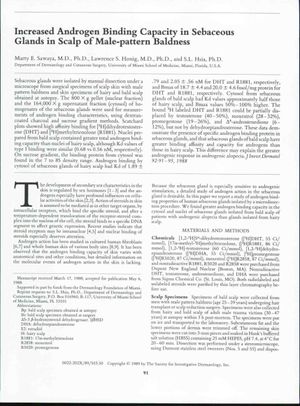Increased Androgen Binding Capacity in Sebaceous Glands in Scalp of Male-Pattern Baldness
January 1989
in “
Journal of Investigative Dermatology
”
androgen binding capacity sebaceous glands male-pattern baldness androgen receptor dissociation constants type I binding dihydrotestosterone DHT methyltrienolone testosterone enzymatic activity androgenic alopecia receptor analysis human hair follicles hyperandrogenization male-pattern baldness DHT androgenic alopecia

TLDR Men with male-pattern baldness have more androgen receptors in their scalp's oil glands, which may contribute to hair loss.
The study from 35 years ago found that sebaceous glands in the scalp of individuals with male-pattern baldness have a higher androgen binding capacity compared to those with hair. Specifically, the androgen receptor content in bald scalp was nearly three times greater than in hairy scalp. The dissociation constants for type I binding were similar, indicating similar affinities between bald and hairy scalps. The study suggested that the increased androgen receptor content in bald scalp sebaceous glands might contribute to the development of male-pattern baldness. Additionally, the study confirmed that dihydrotestosterone (DHT) and methyltrienolone bind to the same receptor sites, with testosterone showing a weaker affinity. This increased binding capacity, along with greater enzymatic activity noted in previous research, could provide a biochemical basis for androgenic alopecia. Further research on receptor analysis in human hair follicles was expected to shed more light on skin diseases related to hyperandrogenization.
